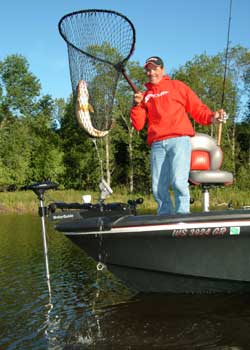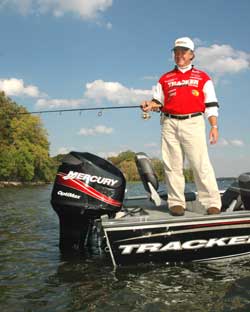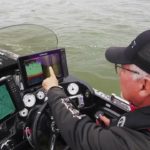The Digs on Walleye Jigs

Lift, drop, lift, drop … Pow! That’s what makes jig fishing for walleyes so addictive. That instant gratification when fish connects to lure. The connection that telegraphs an unmistakable thump to the angler’s touch. It’s the closest thing to hand-to-hand combat that there is in walleye fishing. The amazing thing is how basically simple the jig is: lead and steel, common materials, brought to life by the magic of an anglers hand. This article will explore the “magic” and the ideology behind the jigging presentation that can often make the difference between getting a bite and going home skunked.
I have spent many hours over the years fishing along side some of the walleye world’s best jiggers. Some days I’ve been able to hold my own … other days I’ve been put to shame. But on every outing there was learning … the kind of in-depth angling brain food that can only be passed by those that truly know what makes a jig work … what makes the seemingly simple jig, not so simple after all.
I recently did an informal poll of some of the better jig fishermen I know to get their thoughts. The targets of this inquiry included the 2004 PWT Angler of the Year, Tommy Skarlis of Walker, Minnesota, an angler well known among walleye fishing enthusiasts as a true “jig master”, Daryl Christianson of Montello, Wisconsin and Hall of Fame Legendary Angler Gary Parsons of Glidden, Wisconsin. My questions were few but poignant: 1. “What is your favorite jig style for vertical jigging techniques?” 2. “What’s your favorite jig style for pitching scenarios?” and, 3. “If you could fish with only one jig, what would it be?”
On the subject of jigs for vertical jigging, the consensus was that jigs with long-shanked hooks were the hands-down favorite. “You don’t want the fish grabbing the jig by the head … that’s #1.” Says Christianson, “I think that’s what happens a lot when you get a bite on a jig and miss the fish … he’s just grabbed the head of the jig and missed the hook. A long-shanked jig gives you a better hook for threading the bait on, and keeps it away from the head of the jig cutting down on missed fish.” Gary added that the physics involved in a vertical hook set have much to do with why a long-shanked jig is better in this scenario. “When you set the hook vertically, a long-shanked jig provides a cam action that drives the hook point into the roof of the fish’s mouth. With a short-shanked jig, there’s less hook in the fish’s mouth upon the hook set and a much greater chance that the jig will be pulled out before the hook hits flesh.”
 I also learned that a jig’s head design plays a large role in the angler’s hooking percentage. Parsons explained “If you have done any amount of jig fishing for walleyes, you have no doubt found that as many as half your bites come as the jig is on the bottom. A stand-up or semi-stand-up style jig head, like that found on the XPS Walleye Angler Jigs, positions the hook and the bait so that it’s much easier for the walleye to see and then inhale the bait.” Daryl agrees, adding “I’ve tried short-shanked stand-up style jigs and have found they just don’t balance very well and tend to tip over, where as the longer shanked stand-ups like the Bait Rigs Odd’Ball Jig, keep the bait up off the bottom where the fish can have a better chance of picking it up.”
I also learned that a jig’s head design plays a large role in the angler’s hooking percentage. Parsons explained “If you have done any amount of jig fishing for walleyes, you have no doubt found that as many as half your bites come as the jig is on the bottom. A stand-up or semi-stand-up style jig head, like that found on the XPS Walleye Angler Jigs, positions the hook and the bait so that it’s much easier for the walleye to see and then inhale the bait.” Daryl agrees, adding “I’ve tried short-shanked stand-up style jigs and have found they just don’t balance very well and tend to tip over, where as the longer shanked stand-ups like the Bait Rigs Odd’Ball Jig, keep the bait up off the bottom where the fish can have a better chance of picking it up.”
When it comes to choosing the right weight jig for the situation at hand, Parsons and Christianson both follow the guidelines of using the lightest jig possible as long as you can maintain a vertical presentation, feel and bottom contact. The light weight of the jig is said to be an advantage in that it allows the walleye to more easily inhale the offering … the most popular sizes being quarter ounce and three eighth ounce for vertical jigging applications. Tommy Skarlis on the other hand is among a growing segment of jig fishermen that opt to fish “heavy metal” style. “My number one go-to vertical jigging jig would have to be the Lindy five eighth ounce Jumbo Fuzz-E Grub head.” stated Skarlis, “It has an aqua-dynamic head design, meaning its longer and taller than it is wide. That shape allows the jig to track very straight in the water and is weighted in such a way that it falls straight and doesn’t roll or tip in current.” Skarlis continued, “The heavier weight is important too, allowing me to always maintain bottom contact and gives me complete control of the jig at all times.”
On the subject of jigs used for casting or pitching techniques, the answers were decidedly different. Daryl likes the short shank style for casting, but favors a swimming style jig. “The Slo-Poke jig is nice for casting situations because it moves horizontally in the water, falls slower than standard round-head jigs and because of the eye located on the forward nose of the jig its great for working through weeds and sparse cover.” Skarlis too looks for a wide gap hook when choosing a casting jig, adding “I almost always fish with some sort of plastic on my jigs too, and find that a wide gap hook like those on Lindy’s Max Gap jigs, give plenty of bite for good hook-ups even when dressed with a bulkier piece of plastic.”
To be honest, my initial purpose for the study was to determine if in fact there was one jig that could do it all. With that in mind I offered each of the anglers my challenge to answer the question, “If you could only fish with one jig … one size, one color, what would it be?” The answers I got put me a little back on my heels, but in essence it was something like “The one that would catch the most fish in the given situation.” No one ever said interviewing fishermen was easy … but in reflection, what I learned was that jigs have become a refined and specialized category of lures. All those different jigs that line the shelves of bait shops every where you go will catch fish … provided you tie on the right one under the right conditions and present it in the right manner.





